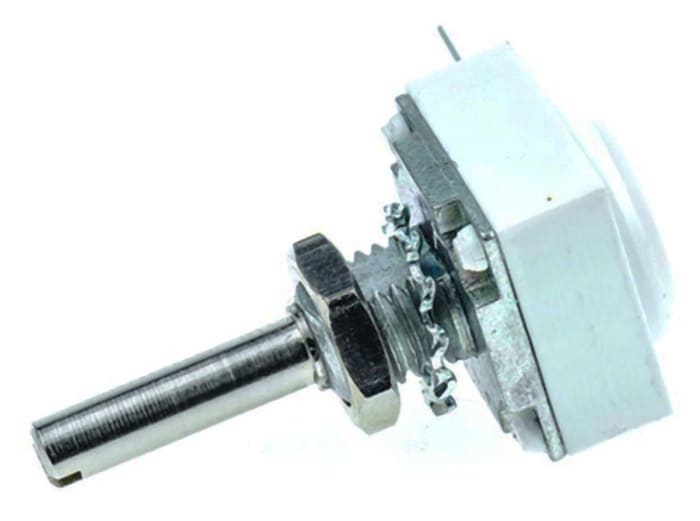Technical Document
Specifications
Brand
RS ProPotentiometer Type
Rotary
Maximum Resistance
5kΩ
Number of Gangs
1
Number of Turns
1
Electrical Taper
Linear
Element Material
Conductive Plastic
Mounting Type
Panel Mount
Termination Style
Wire Lead
Shaft Length
17mm
Shaft Diameter
3 mm
Shaft Type
Circular
Travel Length
12.5mm
Actuator Type
Linear Shaft
Tolerance
±20%
Distrelec Product Id
30403020
Country of Origin
United Kingdom
Product details
RS PRO Conductive Rotary Potentiometers
Brought to you by RS PRO, these rotary conductive potentiometers offer a range of resistance options. suitable for various applications. Each model is perfect for applications requiring constant use. Comes complete with a 1.25 mm mechanical travel at either end. Perfect for use on PCB boards, automotive or other electronics. All models are highly reliable and excellent quality.
Features and Benefits
• Glass-filled nylon bodied sensor with 10mm electrical stroke and a spring-loaded plunger
• For best results, use as a potential divider (not variable resistor) and buffer the resulting output with a high impedance amplifier
• Output Smoothness 0.5 % (Max)
• Resistance 5 kΩ linear (±20%)
• Connection via 0.2m flying leads
• Linearity of ±2 % & Temperature Coefficient of ±200 ppm / °C
What is a potentiometer?
A potentiometer is a variable resistor which increases or decreases the resistance in an application. Usually available as either digital or analogue, there are two main types of potentiometers, rotary and linear.
• Linear - comes in a rectangle strip shape and can be pulled up or down for the required resistance, Used a lot within sound systems for mic output or volume control.
• Rotary - the shaft is housed by a knob, you would find these on dimmer switches or speakers, turning (usually to the right) will increase the resistance amplifying the output, whether that is light, sound or voltage.
How do potentiometers work?
Used in various applications, potentiometers operate as a resistor for electronic devices. As an example, a dimmer switch you would find in place of a light switch would house a potentiometer. Whichever direction it is turned, either increases or decreases the resistance, manipulating the light output from the bulb. Another common use would be speaker or sound systems, operating as a volume switch. There are various types of element material, usually as rotary or linear, such as:
• Wire-wound
• Conductive
• Plastic
• Carbon
• Cermet
Stock information temporarily unavailable.
Please check again later.
P.O.A.
1
P.O.A.
1
Technical Document
Specifications
Brand
RS ProPotentiometer Type
Rotary
Maximum Resistance
5kΩ
Number of Gangs
1
Number of Turns
1
Electrical Taper
Linear
Element Material
Conductive Plastic
Mounting Type
Panel Mount
Termination Style
Wire Lead
Shaft Length
17mm
Shaft Diameter
3 mm
Shaft Type
Circular
Travel Length
12.5mm
Actuator Type
Linear Shaft
Tolerance
±20%
Distrelec Product Id
30403020
Country of Origin
United Kingdom
Product details
RS PRO Conductive Rotary Potentiometers
Brought to you by RS PRO, these rotary conductive potentiometers offer a range of resistance options. suitable for various applications. Each model is perfect for applications requiring constant use. Comes complete with a 1.25 mm mechanical travel at either end. Perfect for use on PCB boards, automotive or other electronics. All models are highly reliable and excellent quality.
Features and Benefits
• Glass-filled nylon bodied sensor with 10mm electrical stroke and a spring-loaded plunger
• For best results, use as a potential divider (not variable resistor) and buffer the resulting output with a high impedance amplifier
• Output Smoothness 0.5 % (Max)
• Resistance 5 kΩ linear (±20%)
• Connection via 0.2m flying leads
• Linearity of ±2 % & Temperature Coefficient of ±200 ppm / °C
What is a potentiometer?
A potentiometer is a variable resistor which increases or decreases the resistance in an application. Usually available as either digital or analogue, there are two main types of potentiometers, rotary and linear.
• Linear - comes in a rectangle strip shape and can be pulled up or down for the required resistance, Used a lot within sound systems for mic output or volume control.
• Rotary - the shaft is housed by a knob, you would find these on dimmer switches or speakers, turning (usually to the right) will increase the resistance amplifying the output, whether that is light, sound or voltage.
How do potentiometers work?
Used in various applications, potentiometers operate as a resistor for electronic devices. As an example, a dimmer switch you would find in place of a light switch would house a potentiometer. Whichever direction it is turned, either increases or decreases the resistance, manipulating the light output from the bulb. Another common use would be speaker or sound systems, operating as a volume switch. There are various types of element material, usually as rotary or linear, such as:
• Wire-wound
• Conductive
• Plastic
• Carbon
• Cermet

